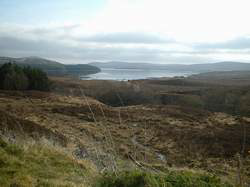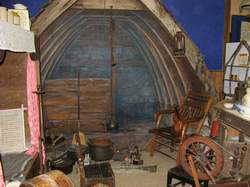Abandoned Communities ..... Strathnaver
Strathnaver lies in what was once the county of Sutherland. It is the valley of the river Naver, which flows from Loch Naver in a northerly direction for about twenty miles until it enters the sea on the north coast of Scotland near the small town of Bettyhill.
In 1814 the valley was occupied by about forty small settlements, each comprising a group of dwellings that were home to between three and fifteen tenant families. As well as the tenant families there were inhabitants who had no rights of tenure. They were the cottars, living in hovels, and, as Richard Muir has described, employed as cobblers, weavers, or smiths, and engaging in agricultural work.
Richard Muir, The Lost Villages of Britain, Book Club Associates, 1985, ch 7.
In addition there were a number of transient people, tinkers who might engage in seasonal work on the farms or undertake minor repairs.
It was a Gaelic speaking community. The rate of literacy would have been low, but in common with many Highland communities the people of Strathnaver probably enjoyed frequent cultural activities that included the playing of music, singing, and reciting of poems. It is likely that these activities preserved a sense of the history of the community and its valued traditions.
In material terms the community was poor, with intermittent periods of great hardship as a result of crop failure or disease. Houses were constructed out of basic materials obtained locally such as turf, stones, a limited amount of wood, clay, and thatch. They were cramped, poorly ventilated, and very dark. Their floors were beaten earth. Cattle and other animals would often occupy the same premises, though by the nineteenth century there would usually have been a wall between them and the human residents.
Some impression of the living conditions of people in Strathnaver can be gained from visits to the Strathnaver Museum in Farr and the Highland Folk Museum in Newtonmore. At the Highland Folk Museum you can see dwellings constructed in the traditional manner, while at the Strathnaver Museum there is a simulation of a typical home interior, with a bed, fireplace, storage vessels, furniture, tools, and a violin.
In 1814 the valley was occupied by about forty small settlements, each comprising a group of dwellings that were home to between three and fifteen tenant families. As well as the tenant families there were inhabitants who had no rights of tenure. They were the cottars, living in hovels, and, as Richard Muir has described, employed as cobblers, weavers, or smiths, and engaging in agricultural work.
Richard Muir, The Lost Villages of Britain, Book Club Associates, 1985, ch 7.
In addition there were a number of transient people, tinkers who might engage in seasonal work on the farms or undertake minor repairs.
It was a Gaelic speaking community. The rate of literacy would have been low, but in common with many Highland communities the people of Strathnaver probably enjoyed frequent cultural activities that included the playing of music, singing, and reciting of poems. It is likely that these activities preserved a sense of the history of the community and its valued traditions.
In material terms the community was poor, with intermittent periods of great hardship as a result of crop failure or disease. Houses were constructed out of basic materials obtained locally such as turf, stones, a limited amount of wood, clay, and thatch. They were cramped, poorly ventilated, and very dark. Their floors were beaten earth. Cattle and other animals would often occupy the same premises, though by the nineteenth century there would usually have been a wall between them and the human residents.
Some impression of the living conditions of people in Strathnaver can be gained from visits to the Strathnaver Museum in Farr and the Highland Folk Museum in Newtonmore. At the Highland Folk Museum you can see dwellings constructed in the traditional manner, while at the Strathnaver Museum there is a simulation of a typical home interior, with a bed, fireplace, storage vessels, furniture, tools, and a violin.
Strathnaver was part of the estate of the Countess of Sutherland. The Countess of Sutherland owned most of the county of Sutherland. Traditionally the relationship between landlords and their tenants in the Highlands had been one in which the landowner enjoyed total authority while being expected to care for the people and help them through more difficult times. Men of a suitable age range would have accepted an obligation to provide military service on behalf of the landlord whenever called up. On a large estate, and the Sutherland estate was very large indeed, tenants would rarely have a face to face meeting with the landowner. Most administrative work, including the collection of rents, was done by agents known as factors or tacksmen.
By 1814 the clearance of people from the land had been going on in other parts of the Highlands for about forty years. The general social and economic changes that gave rise to the clearances have been described by Robert Dodgshon and Eric Richards.
R A Dodgshon, From Chiefs to Landlords: Social and Economic Change in the Western Highlands and Islands c.1493-1820, Edinburgh University Press, 1998.
Eric Richards, The Highland Clearances, Birlinn, 2000.
The changes included a steady growth in population. With food production always precarious, it became increasingly difficult to find land for additional inhabitants. The introduction of potato cultivation provided some respite, but it was only temporary. One option for the people was voluntary emigration. Some chose to move south, others migrated overseas, in particular to Canada and the USA. It seems that at first landowners were reluctant to encourage emigration, but by 1814 they were often willing to allow tenants to move away and sometimes tacitly supported it.
By the start of the nineteenth century the people of the Highlands had suffered major social and psychological changes as a result of the defeat of the Jacobite rebellion at Culloden in 1746. To ensure that no such uprising could occur again the British government carried through many measures designed to integrate the Highlands more closely into British society. Some measures were punitive, others brought developments that on the whole could be seen as positive, for instance improved communications, new crops and more efficient farming methods, and the opening of schools. There was a general attempt to bring about "improvement".
By 1814 the clearance of people from the land had been going on in other parts of the Highlands for about forty years. The general social and economic changes that gave rise to the clearances have been described by Robert Dodgshon and Eric Richards.
R A Dodgshon, From Chiefs to Landlords: Social and Economic Change in the Western Highlands and Islands c.1493-
Eric Richards, The Highland Clearances, Birlinn, 2000.
The changes included a steady growth in population. With food production always precarious, it became increasingly difficult to find land for additional inhabitants. The introduction of potato cultivation provided some respite, but it was only temporary. One option for the people was voluntary emigration. Some chose to move south, others migrated overseas, in particular to Canada and the USA. It seems that at first landowners were reluctant to encourage emigration, but by 1814 they were often willing to allow tenants to move away and sometimes tacitly supported it.
By the start of the nineteenth century the people of the Highlands had suffered major social and psychological changes as a result of the defeat of the Jacobite rebellion at Culloden in 1746. To ensure that no such uprising could occur again the British government carried through many measures designed to integrate the Highlands more closely into British society. Some measures were punitive, others brought developments that on the whole could be seen as positive, for instance improved communications, new crops and more efficient farming methods, and the opening of schools. There was a general attempt to bring about "improvement".
One
This picture was supplied by Mandy and Lindsay Smith, who run a B & B in Altnaharra that can be highly recommended
Loch Naver
The River Naver, looking south
The house of a tenant, at the Highland Folk Museum
Inside the tenant’s house
Inside the cottar’s house
At the Strathnaver Museum, a more cluttered interior





